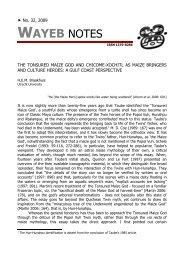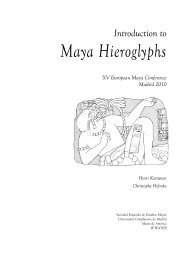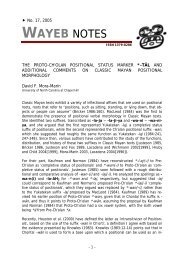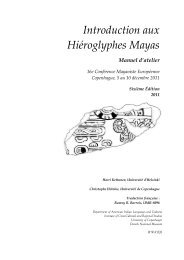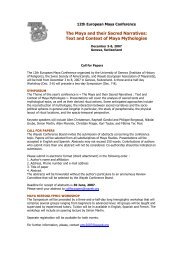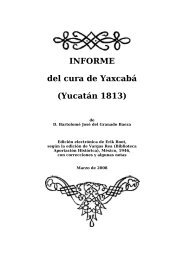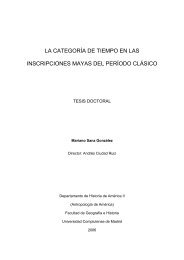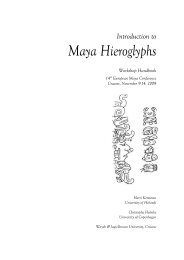Introduction to Maya Hieroglyphs - Wayeb
Introduction to Maya Hieroglyphs - Wayeb
Introduction to Maya Hieroglyphs - Wayeb
Create successful ePaper yourself
Turn your PDF publications into a flip-book with our unique Google optimized e-Paper software.
Kettunen & Helmke 2011<br />
<strong>Maya</strong> <strong>Hieroglyphs</strong><br />
FOREWORD<br />
During the past four decades we have witnessed groundbreaking developments in the field of <strong>Maya</strong> epigraphy.<br />
The purpose of this handbook is <strong>to</strong> provide an introduction <strong>to</strong> the study of <strong>Maya</strong> hieroglyphs and is designed <strong>to</strong><br />
be used in conjunction with <strong>Maya</strong> hieroglyphic workshops. It is our objective <strong>to</strong> summarize and render<br />
comprehensibly the recent developments of <strong>Maya</strong> epigraphy (i.e. hieroglyph studies). The audience targeted is<br />
that of beginners attending <strong>Maya</strong> hieroglyphic workshops 3 .<br />
The authors wish <strong>to</strong> receive any possible comments on the contents and structure of this handbook in order for us<br />
<strong>to</strong> be able <strong>to</strong> produce improved versions in the future. Readers of this handbook are advised <strong>to</strong> realize, as noted<br />
above, that this introduction is intended <strong>to</strong> be used in combination with the workshops provided, i.e. the<br />
handbook only presents a skele<strong>to</strong>n of the writing system, and <strong>to</strong> get the best out of the current volume, the reader<br />
is suggested <strong>to</strong> participate in the workshops and lectures provided by numerous individuals and institutes<br />
around the world offering workshops on the Ancient <strong>Maya</strong> script.<br />
ACKNOWLEDGMENTS<br />
Over the years we have had the opportunity and privilege <strong>to</strong> work in collaboration with the world’s best<br />
epigraphers and have often had the opportunity <strong>to</strong> learn of new decipherments first-hand from the people who<br />
made these discoveries. As we owe a great deal of our intellectual baggage <strong>to</strong> the insight of our colleagues, we<br />
would like <strong>to</strong> acknowledge them collectively for their contribution <strong>to</strong> this workshop handbook, be it conscious or<br />
unconscious, direct or unwitting. These are Dmitri Beliaev, Erik Boot, Pierre Robert Colas, Hugo García<br />
Capistrán, Nikolai Grube, Stanley Guenter, Stephen Hous<strong>to</strong>n, Kerry Hull, Alfonso Lacadena, Barbara MacLeod,<br />
Simon Martin, Peter Mathews, Joel Palka, Carlos Pallán Gayol, Christian Prager, Linda Schele, David Stuart, Erik<br />
Velásquez García, Robert Wald, Søren Wichmann, and Marc Zender.<br />
Special thanks are addressed <strong>to</strong> the colleagues who have made valuable suggestions and corrections <strong>to</strong> the earlier<br />
versions of this handbook: namely Ramzy Barrois, Ignacio Cases, Wilhelmina Dyster, Alfonso Lacadena, Simon<br />
Martin, Christian Prager, Verónica Amellali Vázquez López, and Søren Wichmann. Furthermore, we would like<br />
<strong>to</strong> thank Antti Arppe and Matti Miestamo for their insightful and constructive observations and consequent<br />
modifications of the linguistic part of this volume. Also, our thanks go <strong>to</strong> the following people who have had an<br />
influence on the present volume: Michael Coe, An<strong>to</strong>nio Cuxil Guitz, Albert Davletshin, Lolmay Pedro García<br />
Matzar, Ian Graham, Sven Gronemeyer, Scott Johnson, John Justeson, Terry Kaufman, Justin Kerr, Guido<br />
Krempel, Danny Law, John Montgomery, Dorie Reents-Budet, Joel Skidmore, and Mark Van S<strong>to</strong>ne. Moreover, we<br />
would like <strong>to</strong> thank the late Linda Schele for initiating the formula of the workshops on <strong>Maya</strong> hieroglyphic<br />
writing.<br />
Last but not least, the authors would also like <strong>to</strong> express more personal gratitudes. The Senior author thanks Asta,<br />
Hilla, and Otso Kettunen for their support and affection. The Junior author wishes <strong>to</strong> thank Reinhart, Françoise<br />
and Eric Helmke and Julie Nehammer Helmke for unflagging emotional support.<br />
Due <strong>to</strong> the fact that this handbook is designed for beginners’ purposes and intended <strong>to</strong> be a concise introduction<br />
<strong>to</strong> the <strong>to</strong>pic, we find it extraneous <strong>to</strong> cite all the people involved in deciphering particular hieroglyphs or<br />
producing ideas, insights, and discoveries related <strong>to</strong> the subject. We would therefore like <strong>to</strong> apologize for any<br />
substantial omissions regarding ignored acknowledgements, and would welcome feedback in this regard.<br />
3<br />
This handbook is also designed for more advanced students, and it should be noted here that some parts of the current volume (e.g. Chapter 4.<br />
Conventions of Transliterating and Transcribing <strong>Maya</strong> Texts, Appendix I: Synharmonic vs. Disharmonic Spelling, Underspelled Sounds, and<br />
Reconstructed Glottal Fricatives in <strong>Maya</strong> Hieroglyphic Writing and Appendix J: Notes on Classic <strong>Maya</strong> Grammarare intended for students<br />
already exposed <strong>to</strong> the <strong>Maya</strong> writing system, and are only expected <strong>to</strong> be skimmed through by beginners. This <strong>Introduction</strong> is intended <strong>to</strong> be as<br />
short as possible as regards <strong>to</strong> the main part of the volume, but additional information is provided <strong>to</strong> the audience with extra craving for the<br />
intricacies of the <strong>Maya</strong> script.<br />
6/154



